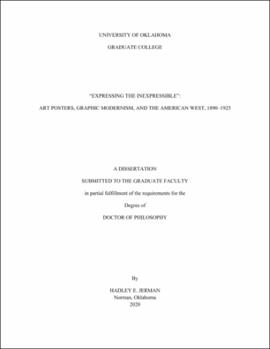| dc.description.abstract | The “art poster” movement swept the United States during the 1890s, generating enthusiasm and commentary for advertising posters designed by fine artists. While American art posters prompted much discussion in their time, they have rarely received focused art historical investigation. And while the movement informed advertising efforts in the American West through the early 1920s, scholars have largely ignored western centric posters. This dissertation fills that lacuna and offers a methodological framework for addressing not only western American posters but commercial art more broadly. It considers posters made between 1890 and 1925 in New York, New Mexico, and California as the tangible outcome of compromises between multiple makers. Thus, through case studies, I seek to understand how art posters of the American West visually negotiated between the needs and expectations of various stakeholders to “sell” ideas about the West. As this study reveals, art posters critically comment on and interpret the ideas and objects they were designed to sell. At the turn of the twentieth century, art poster style informed the visual identity of William F. “Buffalo Bill” Cody’s Wild West even though his posters generally eschew the aesthetic. Edward Penfield’s poster promoting Frederic Remington’s book, Pony Tracks (1895), reveals the direct influence of Cody’s Wild West on New York perceptions and portrayals of the West. Rather than celebrate Remington’s vision, however, I argue that Penfield’s poster and cover design interpreted and criticized it. Likewise, while Gerald Cassidy’s 1922 Santa Fe Fiesta posters worked to advance tourism for his clients, they simultaneously promoted the artist and Pueblo land rights. While Maynard Dixon’s billboard designs manipulated public attitudes favorably toward outdoor advertising for his employer and promoted California for local advertising boosters, for the artist they served as a crucible in which to explore compositional structures that informed his fine art for decades. Such posters’ appearance of simplicity and instantaneous communication demands we afford them a longer look. Doing so equips us to more critically consume the advertising images that surround us. What might we discover if only we looked more closely, not only at the tangible images of our collective past, but at the commercial imagery that continues to pervade our visual experience today? | en_US |
